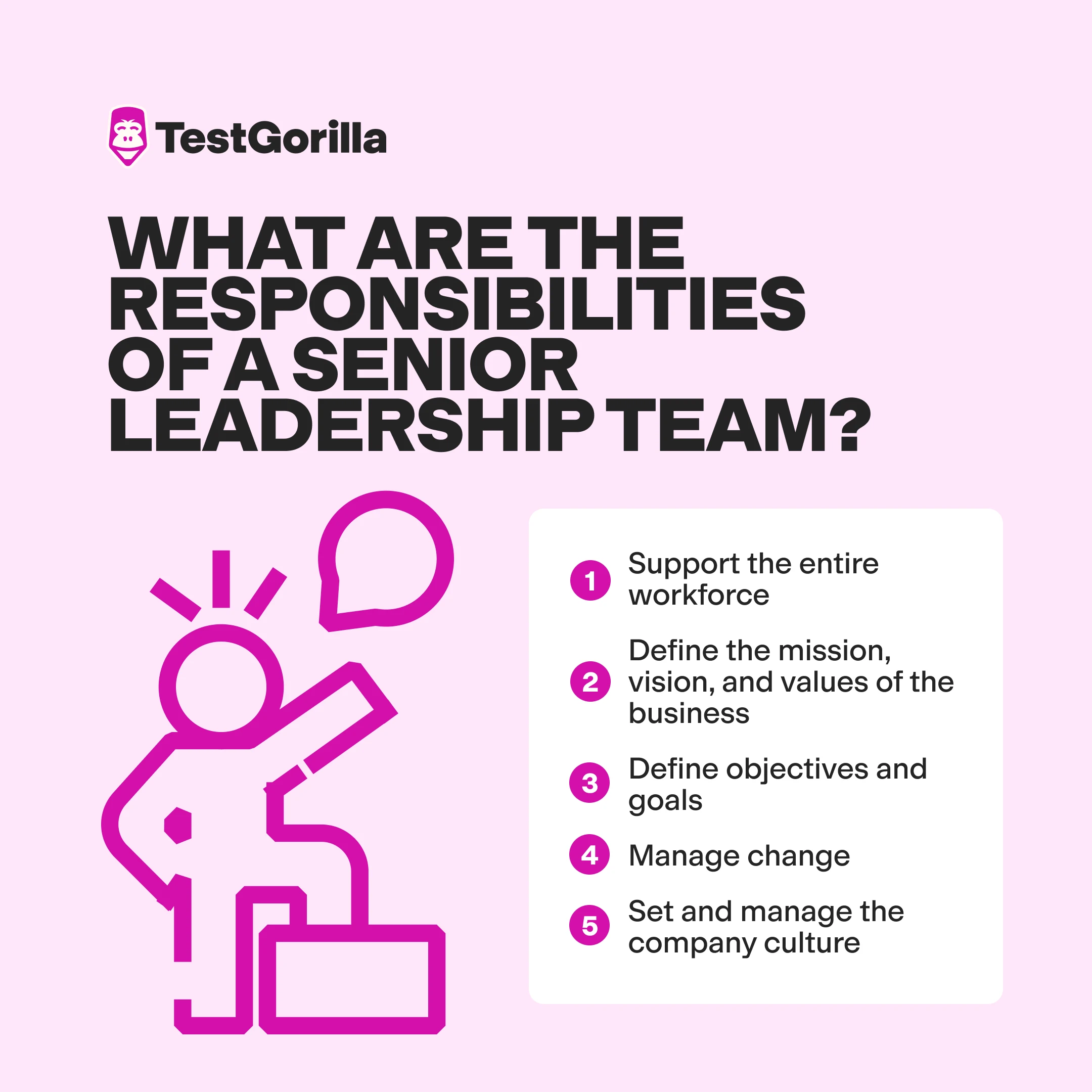Senior leadership teams: 5 key characteristics of effective teams
Use talent assessments to objectively hire the most competent leaders
Successful companies are built on the backs of knowledgeable, influential leaders.
A strong senior leadership team maintains the organizational structure, determines high-level goals, and sets the tone for the rest of the company.
Therefore, it goes without saying that hiring for senior leadership team roles carries high stakes for the company.
In this article, we describe different senior leadership roles, identify what makes a great leadership team, and explain how to accurately identify the best candidate for the job using aptitude tests like our Leadership and People Management test.
Table of contents
- What is a senior leadership team?
- What are the different senior leadership team roles?
- 5 key characteristics of effective senior leadership teams
- How to hire an outstanding senior leadership team using TestGorilla
- Build a high-performing senior leadership team to set your business up for success
- Senior leadership team roles FAQs
What is a senior leadership team?
A senior leadership team consists of senior managers, executives, and directors from different departments within the company. Senior leadership also often refers specifically to the highest-ranking executives in the company whose titles start with “chief,” such as chief executive officer or chief financial officer.
Apart from representing and being in charge of their respective departments, the senior leadership team meets regularly to:
Discuss day-to-day business operations
Set the overall direction of the company
Solve problems
Allocate resources
Talk about new and existing products
Establish organization-wide policies
Check that the company is in line with its goals and values
While the specific composition and responsibilities of a senior team vary according to the company and its structure, their goal remains the same: Ensure sustainable business growth.
What are the responsibilities of a senior leadership team?
So, what is senior leadership in terms of responsibilities in the company? There are a number of key functions leadership team roles must fulfill, such as:
Responsibilities | Description |
Support the entire workforce | - Provide appropriate resources, tools, training, and inspiration to help staff perform their jobs efficiently - Create a positive work environment that fosters growth and engages employees |
Define the mission, vision, and values of the business | - Instill the values of the business into employees - Explain what the company is doing and what the long-term plans are |
Define objectives and goals | - Define the roles and responsibilities of each employee - Identify areas for improvement and required resources - Establish metrics to measure progress and success |
Manage change | - Reallocate resources - Resolve issues - Make critical decisions - Devise and implement strategies to successfully manage change |
Set and manage the company culture | - Define company values - Model and reward positive behaviors - Hire people who contribute positively to company culture |
What are the different senior leadership team roles?
The chief executive officer, chief operating officer, chief administrative officer, and chief financial officer are some of the most commonly recognized senior leadership team roles. However, several other roles fall under the umbrella of chief executives.
The chief executives make up the “C-suite,” which refers to the group of people holding the highest-level management positions in an organization. Let’s define some of these roles individually.
Chief executive officer (CEO)
The chief executive officer is typically the face of the company. They are the highest-level corporate executive and are usually a part of the founding team as well.
Chief executive officers frequently consult with other members of the senior leadership team to make major decisions. They can come from any background, whether technical or non-technical. However, they must possess strong leadership and decision-making skills.
Chief operating officer (COO)
A chief operating officer is responsible for handling and overseeing the company’s daily operations and verifying if they follow plans. They aim to improve operational efficiency, reduce costs, and keep the organization on track to meet its goals.
Recruiting a COO for your company? Check out our COO job description template to get started.
Chief financial officer (CFO)
A chief financial officer manages company finances. Their job includes reviewing annual budgets, forecasting expenses and revenue, managing risks, auditing, and financial reporting. They work closely with other members of the leadership team to ensure that the company’s financial status is healthy and stable.
Chief marketing officer (CMO)
It’s the chief marketing officer’s job to promote the company and attract more customers. They are responsible for developing and implementing marketing strategies and overseeing market research, brand management, product development, and customer acquisition efforts.
Chief technology officer (CTO)
The chief technology officer is responsible for addressing the technological needs of the company, such as overseeing the launch of new products and services, aligning the organization’s technology with its business goals, and setting up an infrastructure to enable in-house research and development.
Depending on the company and its needs, other senior leadership team roles can include the chief human resource officer, chief legal officer, chief information officer, and chief communications officer.
The best insights on HR and recruitment, delivered to your inbox.
Biweekly updates. No spam. Unsubscribe any time.
5 key characteristics of effective senior leadership teams
The performance of the executive team largely determines the company's status quo. However, great senior leaders are so rare that companies choose the wrong person for the job 82% of the time, according to Gallup’s research.
Let’s discuss what makes a great leadership team so your company can be on the good side of that statistic.
1. Excellent communication skills
Effective communication is important for any role, but it's especially critical for those in leadership team roles.
Executive team effectiveness hinges on the members’ ability to communicate with each other, their direct reports, and their respective departments.
Senior leaders need to break down departmental silos and manage a diverse team of employees who rely on them for inspiration as well as prioritizing tasks, managing resources, getting feedback, and aligning with the company’s objectives.
They also need to have active listening skills and be willing to hear what employees have to say.
Since research shows that two-thirds of managers aren’t comfortable communicating with their employees, it’s essential to screen your candidates for this skill.
Talent assessments are a great way to quantify and measure soft skills like communication without letting personal bias get in the way. They can accurately identify good communicators versus good interviewees – two groups that are often mistakenly lumped together.
We recommend the Communication (Intermediate) test for senior leadership team roles. It looks like this:
Make the best hire for any role with TestGorilla
Resumes are a poor judge of candidates’ true abilities and potential. With skills tests, you base your hiring decisions on accurate data. See how TestGorilla talent assessments work in action in our live demo.
2. Share a common purpose and goal
Effective leaders motivate and inspire employees by reminding them that they are part of something bigger than themselves and that everyone is on this journey together.
By holding regular team meetings with their subordinates and assigning them key action items, they encourage the team to reach new heights and ensure that everyone is aligned towards a common goal.
Senior leaders also routinely meet with other stakeholders (like investors, community leaders, and politicians) to build the company’s reputation in the wider market and spot opportunities for growth and collaboration.
3. Have strong business ethics
Team members look up to their senior executives and learn from them. The best leaders display strong, clear business ethics and set the tone for the rest of the organization.
By exhibiting honesty, integrity, and ethical behavior, they inspire trust and respect from the employees and help build a positive work culture.
You can evaluate the ethical knowledge of candidates with our online Business Ethics and Compliance test and find candidates who have a strong ethical compass.
Here’s a sample question from the test:
4. Aren’t afraid of change
Businesses evolve constantly. Market trends change, new competitors come in, and customer demands shift.
Being highly adaptable and quick to rethink the company’s strategy depending on the current situation is an increasingly important ability. Strong leaders aren’t afraid of change or taking calculated risks to ensure business sustainability or continuity.
Openness to new ideas, products, and marketing strategies in response to changing circumstances is a key characteristic of an effective senior leadership team.
5. Have a growth mindset
Leaders with a growth mindset are open to feedback and criticism and are willing to learn from their mistakes. They are more focused on the company’s development rather than being right or worrying about their egos.
By encouraging experimentation, new ideas, and innovations, they promote a growth culture in the entire team as well. They also never overlook leadership development programs and mentoring the next generation because they know that proper succession planning is the key to a sustainable business.
How to hire an outstanding senior leadership team using TestGorilla
The kind of data you need to ensure a good senior leadership team hire doesn’t come from resumes. Even if you’re already using skills-based hiring, the question is: Are your evaluations looking at candidates from all angles, or do they stop at relevant industry knowledge?
Multi-measure talent assessments are the best way to predict job performance. Our data shows that 91% of employers who do multi-measure, skills-based hiring are making quality hires every time.
TestGorilla talent assessments enable you to use up to five tests to cover all bases: hard and soft skills, cognitive abilities, personality traits, motivation, and cultural match.
To improve your hiring process for senior leadership team roles and only invite the best-matched candidates to the interview stage, we suggest a test combination like this:
Culture Add: Senior leadership team roles play a crucial part in creating and maintaining a positive culture and pushing the company ethos. This test shows if they can set good examples for the rest of the company.
Communication (Intermediate): Senior leaders define goals, objectives, and company values, so it’s important to check they can communicate effectively and clearly as well as listen to their employees.
DISC or The Big 5 test: Personality tests are useful to predict the candidate’s leadership style. While these tests have no wrong answers, there certainly is a right and wrong type of leader for your team and company situation.
Leadership & People Management test: This test directly evaluates how well candidates handle leadership team roles. The right person has a combination of prioritization, critical thinking, resource allocation, collaboration, and problem solving skills.
Role-specific test: This blank spot is for relevant industry expertise such as marketing, finance, or business operations, depending on the type of leader you’re recruiting.
This is what TestGorilla’s Leadership & People Management test looks like:
Here’s another sample, this time from the Business operations management test:
Pilgrims’ Friend Society, an organization that provides residential care homes and independent housing for the elderly, hires for executive roles using TestGorilla.
Since switching from ad-hoc aptitude evaluations to using TestGorilla’s extensive test library, the company has been able to gather all the important data about their applicants more quickly and accurately.
Pilgrims’ Friend Society uses skills tests to pinpoint knowledge in areas it previously didn’t have a way to evaluate, along with highly specialized role skills. The result: better quality senior leadership hires in less time.
Make data-driven hiring decisions with TestGorilla talent assessments
TestGorilla helps you identify the top talent in your pipeline and ensures you hire the most suitable leaders for your company – and it’s 100% free. Sign up and start planning your senior leadership assessment today.
For more recruitment details and job description templates, read our guide on hiring great leaders.
Build a high-performing senior leadership team to set your business up for success
Leaders in executive team roles are responsible for creating the strategic direction of the company, promoting a positive work environment, managing change efficiently, and inspiring employees to achieve their objectives.
By evaluating the candidates for your senior team using aptitude tests, you can rest assured they have what it takes to lead. Sign up for the TestGorilla demo to see for yourself.
Watch our product tour to learn how to assemble your assessments.
If you’re ready to hire your next senior leadership team member, create your Free forever plan.
Or, if you’d like to keep reading, check out our article about executive hiring with skills assessments which provides further guidance on this topic.
Senior leadership team roles FAQs
Let’s answer some common senior management team questions:
Who makes up the senior leadership team?
The chief executive officer, chief operating officer, chief administrative officer, chief financial officer, chief marketing officer, and chief technology officer make up the senior leadership team. Depending on the company, other senior leadership team roles can include the chief human resource officer, chief legal officer, chief information officer, or chief communications officer.
What is the role of a leadership team?
The leadership team defines the mission, vision, and values of the business, supports the entire workforce, and does high-level decision-making to steer the company in the right direction. Senior teams have to define the overall objectives and goals of the organization and ensure all employees are working towards them. They also shape, influence, and manage company culture.
Why do senior leadership teams exist?
Senior leadership members make day-to-day decisions in the company’s best interest and have a final say in all business matters. They determine high-level goals and initiatives, make sure each department meets company standards, provide the infrastructure, and allocate the resources to support all employees.
What is the difference between a senior leadership team and executive leadership team?
Both the “senior leadership team” and “executive leadership team” usually refer to the C-suite – the board of the highest-ranking executives in the company whose titles often start with the word “chief,” as in “chief executive officer.”
The term “senior leadership team” can sometimes describe other senior leadership roles, such as senior vice presidents or senior directors, while the term “executive” refers to roles that focus on big-picture strategic planning and overseeing managers lower down on the hierarchy (i.e., heads of, senior managers).
You've scrolled this far
Why not try TestGorilla for free, and see what happens when you put skills first.



























